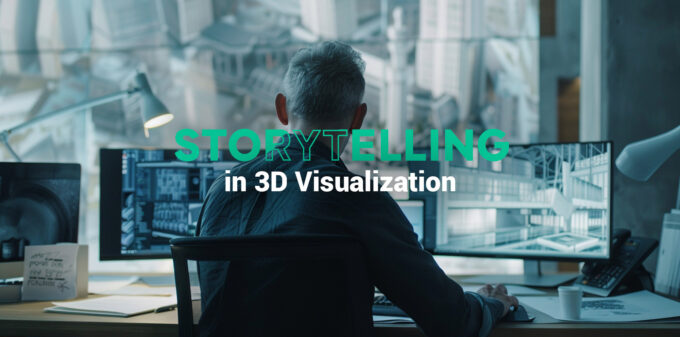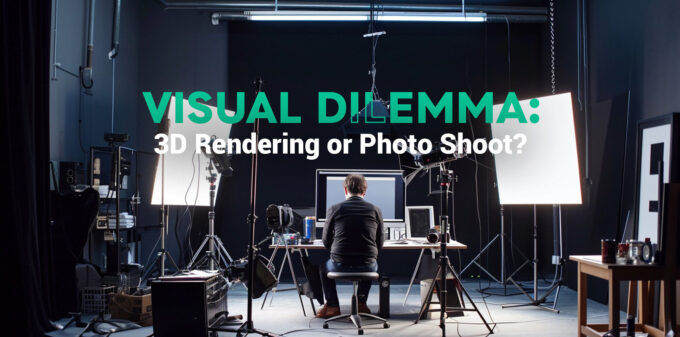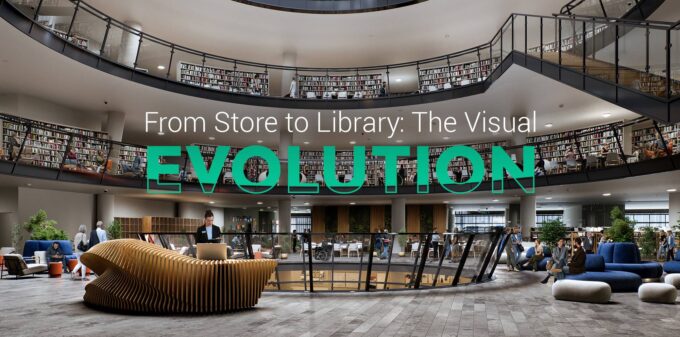
The Art of Storytelling in 3D rendering: Part 2
Storytelling in 3D rendering: Tools, Methods, and Techniques
In our previous article we explored the concept of storytelling in 3D rendering and its importance for visual storytelling. In this article, we build on that theme by presenting key tools and techniques for creating compelling stories in 3D renderings.
Just as writers or filmmakers have their methods and tricks to narrate stories, the field of 3D visualization boasts its own intriguing set of tools. Skillful application of these tools allows 3D artists to weave narratives that not only showcase technical prowess but also evoke emotions and convey a client’s message authentically.
Tools, techniques, and some secrets:
-
Artistic Input:
A creative approach to work is the main thing for a 3D artist. Of course, it is important to clearly convey all the technical nuances, but that is not enough. It is necessary to create the whole project in such a way that it is interesting to look at, that it attracts the eye.Being an artist means infusing your creation with a profound understanding and a touch of uniqueness, ensuring that the client’s message is not just communicated but expressed in a way that resonates authentically.
- Light, as a storyteller, sculpts the visual atmosphere, creating mood. The warmth of a sunset or the cool glow of moonlight serves as a narrative tool, setting the stage and evoking specific emotions within the 3D rendering. Additionally, weather conditions play a crucial role – rain adding melancholy and sunshine evoking joy. Skillful manipulation of lighting and weather enhances the storytelling aspect, guiding the viewer’s perception and reinforcing the desired mood for a more immersive experience.
-
Contextual Elements, Accessories and Characters:
In 3D design, every element and accessory carries information. For example, a luxurious bathroom with traces of water on the floor near the bathtub immediately suggests a recent presence of a person. If we see a visualization of a spacious well-designed loggia, which shows an elegant table with an expensive bottle of wine and a fogged glass with the remains of the drink, we can assume that this is an expensive luxury apartment, where you can enjoy pleasant views from your balcony.If we see people in the visualization, we can tell from their clothing whether they are in the office, on vacation, or in the workroom. People’s clothes and the choice of characters are not randomly selected for visualizations. Each element has to convey a certain information.
-
Contrasting Details:
Playing with contrasting elements adds depth and intrigue. Whether it’s the interplay of light and shadow or the juxtaposition of textures, it creates visual tension, prompting the viewer to explore further. -
Realistic Imperfections:
Perfection can be dull. Introducing subtle imperfections, such as a weathered surface, a slightly asymmetrical shape, scattered fruits on a table, an open window, a curtain swaying in the breeze, or a forgotten toy in a room, adds authenticity. Such details evoke trust in the viewer, helping to establish a connection with the space. -
Angles:
The angle from which a design is presented can evoke different emotions. Finding the right angle is akin to choosing the perfect camera shot in cinematography – it directs the viewer’s perception. -
Motion Blur Effect:
Adding a subtle motion blur effect conveys a sense of movement, hinting at a story unfolding in real-time. It engages the viewer by suggesting action or progression.For instance, in architectural visualizations, this effect can be strategically applied to showcase the bustling activity of a city street, adding a touch of realism to the scene. In product presentations, it aids in highlighting the functionality of a swiftly moving object, accentuating its features and creating a sense of real-time action.
-
Close-ups:
Zooming in brings details to life, unveiling the intricacies that make a design more than just an image.In architectural renderings, focusing on close-ups can showcase the meticulous details of materials, textures, or intricate architectural elements, immersing the viewer in the craftsmanship of the envisioned space. In product design, close-ups highlight the fine details and functionality, allowing the viewer to appreciate the story told through the product’s form and features. Whether it’s the grain of wood in interior design or the precise contours of a product, close-ups guide the viewer’s gaze to the story’s essential elements, creating a more immersive and memorable visual experience.
-
3D Animation:
3D animation brings stories to life using visuals. Imagine a video where the camera moves, and details pop up – it’s like telling a captivating story. Adding a voice to it makes it even more engaging, whether it’s showing cool buildings or highlighting the features of a product. It’s like turning your ideas into a video that people can easily understand and enjoy. So, when you use 3D animation, you’re not just presenting, you’re storytelling. It’s a fun and effective way to share your vision, whether on your website, TV ads, or project presentations. It’s all about making your story unforgettable.
Lighting Effects and Weather Conditions:
In this intricate orchestration, the spectrum of tools for successful storytelling is vast. However, the human factor is indispensable. Only a skilled 3D artist can navigate this repertoire, intuitively selecting the right instruments tailored to the project’s needs and the client’s perspective.
Conclusion
Each narrative crafted through 3D rendering is unique, bearing the imprint of a specific project. The more distinct the narrative, the greater its potential to captivate attention and deliver the desired results for the client. Storytelling becomes a pivotal element in decision-making processes, influencing choices and streamlining outcomes. Leveraging 3D rendering with well-crafted storytelling addresses client concerns, saving time and resources across diverse domains successfully.
The future of 3D rendering in storytelling is marked by continuous technological advancements, promising brands innovative and immersive experiences. Real-time rendering, AR and VR integration, AI-driven enhancements, and interactive customization are pivotal trends shaping this trajectory. These developments signify a future where brands will harness powerful tools to elevate audience engagement and craft compelling narratives that seamlessly blend cutting-edge technology with impactful storytelling.
Unlock your unique story with photorealistic 3D rendering. Contact us for a free consultation and turn your ideas into captivating visuals.













